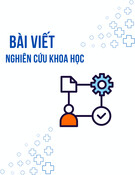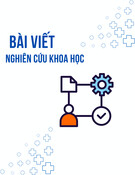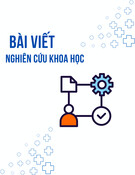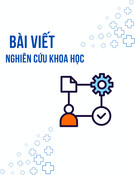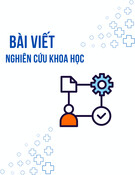
15
https://doi.org/10.52111/qnjs.2025.19202
Tạp chí Khoa học Trường Đại học Quy Nhơn, 2025, 19(2), 15-34
Chuyển đổi số trong hành chính công ở Việt Nam:
nghiên cứu trường hợp tỉnh Bình Định cải thiện chỉ số PAPI
từ 2020 đến hiện nay
Nguyễn Minh Trí*
Khoa Quan hệ Quc tế & Truyền thông, Trường Đại học Ngoại ngữ - Tin học
Thnh ph Hồ Chí Minh, Việt Nam
Ngy nhận bi:20/06/2024; Ngy sửa bi:16/10/2024
Ngy nhận đăng:24/10/2024; Ngy xuất bản:28/04/2025
TÓM TẮT
Chính quyền tnh Bình Định đã có những bước tiến đáng kể trong việc thực hiện chuyển đổi số, với trọng
tâm là nâng cao tính hiệu quả, tính minh bạch và sự hài lòng của người dân. Trong nghiên cứu này, chúng tôi cung
cấp thông tin về những nỗ lực của tnh nhằm cải thiện Ch số PAPI từ năm 2020 đến nay thông qua việc triển khai
các giải pháp đa dạng trên nhiều khía cạnh khác nhau. Với việc sử dụng tiềm năng của các nền tảng điện tử kỹ
thuật số, mạng xã hội, và các công cụ kết nối người dân, tnh Bình Định đã hợp lý hóa một cách thành công các
quy trình hành chính, tối ưu hóa việc cung cấp dịch vụ và thúc đẩy trách nhiệm giải trình cao hơn. Nghiên cứu này
đưa ra những dẫn chứng thực tiễn về các hoạt động cải thiện đáng chú ý, chẳng hạn như nâng cao khả năng tiếp
cận các dịch vụ công của người dân, khả năng đáp ứng và tính minh bạch của chính quyền tnh Bình Định, được
thể hiện qua dữ liệu khảo sát, báo cáo kết quả PAPI qua từng năm. Từ những thông tin có giá trị thực tiễn của tnh
Bình Định, nghiên cứu này sẽ cung cấp những kinh nghiệm quý giá cho các tnh thành khác đang tìm cách khai
thác tiềm năng của công nghệ kỹ thuật số để tăng cường quản trị trong lĩnh vực hành chính công. Tnh Bình Định
trong nghiên cứu này như là một ví dụ điển hình, minh họa cho sức mạnh của chuyển đổi số trong lĩnh vực quản
trị hành chính công.
Từ khóa: Tỉnh Bình Định, chuyển đổi s, chỉ s PAPI, hnh chính công Việt Nam.
*Tc giả liên hệ chính.
Email: trinm@huflit.edu.vn
TRƯỜNG ĐẠI HỌC QUY NHƠN
KHOA HỌC
TẠP CHÍ

16 Quy Nhon University Journal of Science, 2025, 19(2), 15-34
https://doi.org/10.52111/qnjs.2025.19202
QUY NHON UNIVERSITY
SCIENCE
JOURNAL OF
1. INTRODUCTION
Binh Dinh province, one of the five provinces in
the critical economic region of Central Vietnam,
has a favourable geographical location and many
advantageous factors in attracting investment.1
It has emerged as a beacon of progressive
governance in the region. The province has
embarked on a remarkable digital transformation
journey in recent years, driven by a vision to
enhance administrative efficiency, transparency,
and citizen satisfaction. This introduction
provides an overview of the transformative
impact of digital initiatives on the province's
governance landscape, with a particular focus on
improving the PAPI from 2020 to the present. As
digital technologies increasingly revolutionise
governance worldwide,2 Binh Dinh Province
sets a noteworthy example of proactive
adaptation. The integration of digital tools and
platforms into administrative processes has
streamlined operations and fostered a more
inclusive and responsive government.3 This
introduction highlights the pivotal role of digital
transformation in modern governance and
Digital transformation in public administration in Vietnam:
a case of Binh Dinh province's improvement
of PAPI index from 2020 to the present
Nguyen Minh Tri*
Faculty of International Relations & Communicaitons, Ho Chi Minh City University of Foreign
Languages – Information Technology, Vietnam
Received: 20/06/2024; Revised: 16/10/2024
Accepted: 24/10/2024; Published: 28/04/2025
ABSTRACT
The government of Binh Dinh province has made significant progress in implementing digital transformation,
focusing on improving efficiency, transparency, and people's satisfaction. This study provides information on
the province's efforts to improve the PAPI Index from 2020 to the present by implementing various solutions
across different aspects. Binh Dinh province has successfully streamlined administrative processes, optimised
service delivery, and promoted greater accountability by utilising digital electronic platforms, social networks,
and tools to connect people. The study presents practical evidence of notable improvement activities, such as
enhancing people's access to public services and increasing the responsiveness and transparency of the Binh Dinh
provincial government, as indicated by survey data and annual PAPI results. By sharing valuable information from
the experience of Binh Dinh province, this study aims to provide valuable insights for other provinces and cities
seeking to leverage the potential of digital technology to enhance governance in the field of public administration.
Binh Dinh province, in this study, serves as a typical example that demonstrates the impact of digital transformation
in public administration.
Keywords: Binh Dinh province, digital transformation, PAPI index, public administration in Vietnam.
*Corresponding author.
Email: trinm@huflit.edu.vn

Quy Nhon University Journal of Science, 2025, 19(2), 15-34 17
https://doi.org/10.52111/qnjs.2025.19202
QUY NHON UNIVERSITY
SCIENCE
JOURNAL OF
underscores the significance of examining Binh
Dinh Province's experience as a case study.
The purpose of this article is to provide a
comprehensive analysis of Binh Dinh Province's
digital transformation journey and its tangible
impact on governance outcomes, as evidenced
by improvements in the PAPI index. By delving
into the province's results of the PAPI Index
and highlighted implementations, this article
aims to offer valuable insights for policymakers,
practitioners, and scholars interested in
leveraging digital technologies for governance
enhancement. This article seeks to highlight the
transformative potential of digital governance
through a structured exploration of Binh Dinh
Province's digital initiatives and their correlation
with improvements in the PAPI index. By
examining the results of PAPI indexes, combined
with descriptions of outstanding activities of
Binh Dinh province from 2020-2023, this study
contributes to a deeper understanding of the
intricacies of harnessing digital technologies for
effective governance.
Therefore, this introduction sets the
stage for a detailed examination of Binh
Dinh Province's journey towards digital
governance excellence, emphasising the global
implications for governance practices. As digital
transformation continues to shape the future of
governance,4 regions like Binh Dinh Province's
experiences serve as invaluable sources of
knowledge and inspiration for policymakers and
practitioners alike.
2. LITERATURE REVIEW
2.1. Definitions of digital transformation
Digital transformation refers to the strategic
and customer-centric changes in organisations
driven by contemporary information and
communication technologies, aiming to enhance
organisational performance and competitiveness
through new business models.5 It is a business
transformation fueled by emerging technologies,
offering growth opportunities and cost savings.6
The core of digital transformation lies in the
convergence of key technologies like Cloud
Computing, Big Data, the Internet of Things,
and Artificial Intelligence, which impact
various sectors and drive innovation and
disruption.7,8 A comprehensive framework for
digital transformation includes considerations
of societal impact and evolution over time
and 23 categorised drivers termed “digital
transformation interactions”.9 Ultimately, digital
transformation involves a holistic approach
towards implementing new methods to adapt to
the digital economy's competitive landscape and
technological advancements.
From these arguments, digital
transformation in governance refers to the
strategic integration of digital technologies and
innovative processes to enhance administrative
efficiency,10 service delivery,11 and citizen
engagement within governmental entities.12
It involves reimagining and restructuring
traditional bureaucratic systems to leverage the
power of digital tools and data-driven insights.13
This shift extends beyond technological adoption
and fundamentally reevaluates organisational
culture, workflows, and stakeholder relationships.
Digital transformation manifests in
various forms, including the digitisation of
administrative processes, the development of
e-governance platforms, and the implementation
of data analytics for evidence-based decision-
making.14 These initiatives aim to streamline
bureaucratic procedures, reduce administrative
burdens, and improve the overall quality
of public services.15 Furthermore, digital
transformation facilitates greater transparency
and accountability by enabling real-time access
to government information and fostering
increased citizen participation in decision-
making processes.13 One of the most significant
aspects of digital transformation in governance is
its transformative impact on citizen-government
interactions.16 By leveraging digital channels
and citizen-centric platforms, governments can
enhance the accessibility and responsiveness
of public services, thereby improving the

18 Quy Nhon University Journal of Science, 2025, 19(2), 15-34
https://doi.org/10.52111/qnjs.2025.19202
QUY NHON UNIVERSITY
SCIENCE
JOURNAL OF
overall citizen experience.17 Moreover, digital
transformation empowers citizens to actively
engage with government agencies, provide
feedback, and participate in co-creation
initiatives, fostering a more inclusive and
participatory governance model.18
Digital transformation in governance
represents a paradigm shift towards a more
agile, efficient, and citizen-centric approach to
public administration. By harnessing the full
potential of digital technologies, governments
can overcome traditional bureaucratic barriers,
enhance service delivery, and foster greater
trust and accountability in public institutions.19
However, realising the full benefits of digital
transformation requires a concerted effort to
address challenges,20 such as digital literacy,
infrastructure constraints, and privacy concerns,
while fostering a culture of innovation and
collaboration within governmental organisations.
2.2. Definitions of e-government
Governments worldwide are transforming
profoundly in the digital age, transitioning from
traditional bureaucratic models to more agile,
citizen-centric approaches enabled by electronic
government or e-government. At the heart of this
transformation lie several key characteristics
distinguishing e-government from its traditional
counterparts, reshaping the landscape of public
administration and service delivery. That is
the reason why the concept of e-government
was born.
E-government, or electronic governance,
encompasses utilising information and
communication technologies in public
administration.21,22 It involves the digital
transformation of government operations to
enhance service delivery, transparency, efficiency,
and public engagement.23,24 The concept of
e-government is broad, encompassing interactions
between the government, citizens, and businesses
through digital platforms.25 Different approaches
define e-government, including administrative,
technological, and instrumental perspectives,
highlighting its role in modernising public
administration and fostering the development of
an information society.26 E-government is seen
as a tool for offering services, information, and
democratic procedures, ultimately transforming
the traditional hierarchical public administration
system into a more network-based structure.27
As highlighted in the provided contexts,
e-government stands out from traditional
government services due to several key
characteristics. Firstly, e-government leverages
information and communication technologies
to enhance service accessibility, efficiency,
transparency, and accountability.28,29 It enables
the rapid delivery of services, promotes
citizen participation, and fosters trust between
governments and societies.30 Additionally,
e-government emphasises using electronic-based
systems to provide integrated and user-centric
services, catering to the community's needs
while improving service quality.31 This digital
transformation not only streamlines processes
but also aims to increase the effectiveness of
public services by utilising technology.24,26
Adopting e-government signifies a shift towards
modern, efficient, citizen-focused governance
practices.
One of the most notable features of
e-government is its reliance on digital delivery
channels, which revolutionise how citizens
access government services.32 Unlike traditional
government services, which often necessitate
physical visits to government offices or reliance
on paper-based documentation, e-government
services are accessible through digital platforms
such as websites, mobile applications, and
online portals.33 This 24/7 availability ensures
that citizens can access information and conduct
transactions conveniently, transcending the
constraints of office hours and geographic
location.17 Furthermore, e-government
streamlines administrative processes through
digitisation and automation, reducing bureaucracy
and enhancing efficiency.15 Governments can
deliver services more swiftly and cost-effectively

Quy Nhon University Journal of Science, 2025, 19(2), 15-34 19
https://doi.org/10.52111/qnjs.2025.19202
QUY NHON UNIVERSITY
SCIENCE
JOURNAL OF
by digitising paperwork, automating workflows,
and minimising manual interventions.12 This
streamlined approach improves service delivery
and enhances transparency and accountability,13
as citizens can track the status of their applications
and monitor government expenditures through
online platforms.
Personalisation and customisation are also
hallmarks of e-government, allowing governments
to tailor services to individual citizens' needs and
preferences.34 Governments can provide targeted
information, recommendations, and notifications
through user profiles and data analytics,
enhancing the overall user experience.35 This
level of personalisation fosters greater citizen
engagement and satisfaction, driving positive
outcomes for both governments and citizens.36
Moreover, e-government enhances accessibility
for citizens with disabilities or those residing
in remote areas by offering alternative formats,
assistive technologies, and multilingual support.37
This commitment to inclusivity ensures that
all citizens have equal access to government
services, regardless of their geographic location
or physical abilities.38 In addition to these key
characteristics, e-government initiatives often
result in government cost savings by reducing
the need for physical infrastructure, paper-based
documentation, and manual labour.39 Automated
processes and digital transactions minimise
administrative overheads and operational
expenses, allowing governments to allocate
resources more effectively and efficiently.
Therefore, the evolution of e-government
represents a paradigm shift in governance,
leveraging digital technologies to enhance
efficiency, accessibility, and transparency in
public administration. By embracing the key
characteristics of e-government, governments
can deliver services more effectively, empower
citizens, and foster trust and accountability in
government institutions. As the digital revolution
unfolds, e-government will play an increasingly
pivotal role in shaping the future of governance
worldwide.
2.3. Public Administration Performance
Index (PAPI)
The Viet Nam PAPI is a collaboration between
the Centre for Community Support Development
Studies (CECODES) under the Viet Nam
Union of Science and Technology Associations
(VUSTA) and the United Nations Development
Programme (UNDP) in Viet Nam since 2009,
with a close partnership and support of the Centre
for Theory Work of the Viet Nam Fatherland
Front from 2009-2010, the Front Review from
2010-2012, the Commission for People’s
Petitions under the National Assembly Steering
Committee in 2012, and the Centre for Research
and Training of the Viet Nam Fatherland Front—
VFF-CRT from 2013.40 Real-Time Analytics
joined the implementation consortium in 2015
to provide technical platforms for real-time
PAPI data collection and fieldwork monitoring.
Since 2012, the Ho Chi Minh National Political
Academy (HCMA) has partnered with UNDP
Viet Nam to conduct action-based research
using PAPI data and provide PAPI findings to
political leaders and executives through high-
level training programmes.
The Viet Nam PAPI is the country’s
most extensive annual time series; PAPI
assesses three mutually reinforcing processes:
policy making, policy implementation and
the monitoring of public service delivery. The
dimensions are tailored to Viet Nam’s national
and local contexts.41 The philosophy behind
PAPI’s innovative policy monitoring approach
is that citizens are seen as “end-users of public
administrative services” capable of assessing
governance and public administration in their
localities. From 2009 to 2020, PAPI captured
and reflected the experiences of 146.233 citizens
with diversified demographic features. The
result is that Vietnam’s first publicly available
dataset objectively evaluates governance from
the citizens' perspective.42 Based on this citizen
input, PAPI provides a set of objective indicators
that help assess the performance in governance
and public administration while at the same time













